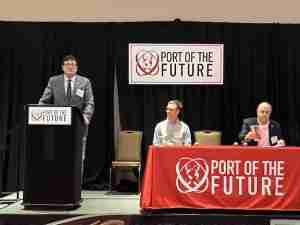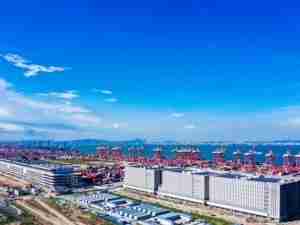Fitch Ratings has affirmed the 'A' rating on Miami-Dade County (the county), Florida's $573.4 million outstanding seaport revenue bonds. The revenue bonds are secured by a senior lien on net revenues from the county's seaport department, PortMiami (the port). The Rating Outlook on the bonds is Stable.
KEY RATING DRIVERS
Summary: The rating reflects PortMiami's leading market position evidenced by its ranking as the largest cruise port in the world and one of the largest ports in the state of Florida in terms of cargo volume. The rating also reflects the port's sizeable minimum annual guaranteed revenues (MAGs), which serve to mitigate potential revenue volatility from competition and economic cycles, coupled with adequate total coverage ratios. However, these strengths are moderated by the port's higher than average leverage compared to peers and the potential for sizable future borrowings.
Leading Position, Robust Competition - Revenue Risk (Volume): Midrange
PortMiami, a global secondary port of call in terms of cargo and a leading cruise port, benefits from stable revenue streams derived from diversified business lines (with cruise operations and cargo representing approximately 53% and 19% of total revenues respectively). The port's recently completed Miami Harbor Project deepened and widened the harbor to accommodate post-panamax ships, added onsite rail, and also added a truck tunnel that provides direct access between the port and the highway. These updates strengthened PortMiami's diversification and provided additional multimodal capability. Port volumes have grown positively over the past decade but still retain some exposure to fluctuations in the cruise business and to the competitive port environment in South Florida and in the south eastern seaboard overall.
Guarantees Stabilize Revenues - Revenue Risk (Price): Stronger
The port benefits from long-term guaranteed contracts with key cruise customers and long-term leases with cargo operators, with minimum guarantees covering approximately 62% of fiscal 2017 operating revenues. Minimum guarantees are expected to cover a substantial 60% to 70% of operating revenues in the medium term, which help to insulate revenues and financial metrics from the port's exposure to volume fluctuations.
Manageable Capital Program - Infrastructure and Renewal Risk: Midrange
The port completed its sizable $1 billion Miami Harbor Project in 2015. A primary focus of the CIP was completion of the deep draft shipping channel to allow larger, post-Panamax ships access to the port, which opened for operation in September 2015. The port's current CIP through fiscal 2021 (year-end Sept. 30) is budgeted at $395 million, with approximately a 75% expected to be debt funded, and the remainder to come from grants and existing funds.
Variable Rate Exposure, Strong Covenants - Debt Structure: Midrange
The revenue bonds are fully amortizing, senior lien debt, supported by very strong structural features such as a MADS based rate covenant and additional bonds test. However, these strengths are tempered by the port's potential exposure to debt interest exposure over time with approximately 30% of outstanding senior lien debt unhedged variable rate bonds and the port's potential sizable debt issuance to support its capital plan. The port is also responsible for payments on the county's seaport general obligation (GO) bonds, which are on parity with the revenue bonds, and the subordinate sunshine state loan payable and capital asset acquisition bonds. While all debt is expected to be repaid by the port's net revenues, all debt besides the seaport revenue bonds are issued through the county and are non-recourse to the port.
Financial Profile
The port's financial profile has historically generated robust DSCR levels above 2.0x for revenue bonds only and 1.6x or higher for combined revenue and GO bonds. More recently, coverage levels for revenue and GO bonds strengthened from 1.9x in 2016 to 2.7x in 2017 primarily due to a one-time contract termination payment and receipt of the first installment of State Comprehensive Transportation System Tax (SCETS) payments. Substantial SCETS payments of approximately $17 million per annum are expected through 2042, subject to state appropriation, which helps to offset the port's escalating debt service profile. Leverage, as measured by net debt for the revenue and GO bonds to CFADS at fiscal year-end 2017 decreased from a somewhat high 7.0x to 5.0x, offset by the SCETS revenues and, given the port's plan for additional debt, leverage may continue to rise.
PEER GROUP
Comparable ports include other Florida ports such as Port Everglades (A/Stable) and Canaveral Port Authority (A/Stable), which serve similar markets and compete with Miami for cargo and cruise business. PortMiami maintains the largest market share of cruise passengers between the three. Its fiscal year-end 2017 leverage is in line with Canaveral, while Port Everglades has very low leverage that is expected to rise over the near term. DSCR across ports is in line with the rating category. With anticipated additional debt issuances, PortMiami's leverage will remain at its current level or migrate upwards. However, the port is able to shoulder a larger debt profile at this rating level, compared to peers, given its size and market cache.
RATING SENSITIVITIES
Future Developments That May, Individually or Collectively, Lead to Negative Rating Action:
- Additional future borrowings increase senior lien leverage above 9.0x for a sustained period, without corresponding increases to net revenues;
- Decreased project revenues without corresponding management of expenses or an increase in debt service, resulting in senior lien coverage levels below 1.6x.
Future Developments That May, Individually or Collectively, Lead to Positive Rating Action:
Upward rating migration is possible should the capital plan be successfully executed and senior lien leverage levels decrease and be maintained below 4.0x as new revenue streams come online.
CREDIT UPDATE
Performance Update
PortMiami's operating revenues continued their trend of strong growth, increasing 16% to $167 million in fiscal 2017, its fifth consecutive year of growth. The increase was attributable to tariff and contract rate increases for cruise ships, an increase in cruise passengers and a one-time recording of a $20 million contract termination fee from Bimini. Cargo volumes were down in fiscal 2017 as routes were diverted for 14 days in September 2017 due to the impact from Hurricane Irma along with a shipping line moving from PortMiami to Port Everglades.
The port's DSCR has historically been strong with levels above 3.0x for revenue bonds and 1.6x or higher for revenue and GO bonds combined. The one-time contract termination fee coupled with the initial SCETS payment drove coverages higher in fiscal 2017. The fiscal 2017 DSCR for revenue bonds only increased to 3.7x from 2.5x and the DSCR for combined revenue and GO bonds rose to 2.7x from 1.9x in fiscal 2016.
Resort World Bimini SuperFast, which was a casino passenger service between the port and a casino in Bimini, Bahamas, entered into a termination of agreement with PortMiami. The company had suspended passenger service in fiscal 2016 and decided to terminate service and its contract in fiscal 2017 due to less passenger usage than expected and higher than anticipated costs for Bimini, from an inefficient ship purchase. The termination required a $20 million payment plus contractual amounts due through March 15, 2017. The payment was paid in 2017 and the port expects to retain the payment in its unrestricted reserves through at least fiscal year-end 2018. Bimini accounted for MAGs of approximately $7 million per year through the forecast period, or 10% of cruise revenues and 5% of total operating revenues.
Contractual guarantees continue to provide a solid anchor for performance at the port, with fiscal 2017 minimum annual guarantees (MAGs) of $109 million equalling roughly 63% of the year's operating revenues. Cruise agreements provide PortMiami with annual guaranteed passenger volumes and revenues while providing the cruise lines with incentives for meeting guaranteed levels. PortMiami is guaranteed between $66 million and $94 million in cruise revenues per year through fiscal 2022, with 3% escalation built into the contracts. While 22 cruise brands operate out of PortMiami, three major cruise companies (Carnival, Norwegian Cruise Line and Royal Caribbean Cruise Line) provide roughly 94% of cruise revenues.
Cargo revenues are also protected through minimum guarantees. PortMiami is a landlord port, with containerized cargo activity handled by three individual terminal operators that occupy approximately 240 acres: Seaboard Marine (Seaboard), South Florida Container Terminal/Terminal Link (SFCT) and the Port of Miami Terminal Operating Company (POMTOC). Total cargo MAGs was $51 million for fiscal 2017, which will rise steadily to $58 million in fiscal 2022. The port recently exchanged acreage allocated to cargo ships in exchange for a reduction in MAGs in order to build additional, higher margin, cruise terminals. The port does not foresee taking additional acreage from cargo at this time however future cruise terminal development may result in additional acreage being needed.
The port is also aided by the pledge of certain SCETS revenues, which were appropriated from the Florida Department of Transportation (FDOT) in fiscal 2017. The port recorded $8 mil in fiscal 2017 and will receive $17 mil per annum through 2042. These monies are gas tax revenues to be appropriated from FDOT to the port in order to reimburse the port's fiscal 2014 $195 million contribution for the Port Miami Tunnel Project. Payments are sized to equal an NPV of approximately $228 million, based on a 5% discount rate.
Fitch Cases
Fitch's base case uses budgeted fiscal 2018 data to project its first year. Thereafter, revenues and expenses are based on management's conservative expectations of future performance, as well as Fitch's own growth assumptions. Unrestricted funds are slowly decreased by approximately $10 million per annum in 2020 and 2021 as the port plans to use a portion of its cash to fund its CIP. Given these factors, total revenues are expected to grow at a CAGR of 3.6%, while expenses grow at a 4.0% CAGR. This produced an average DSCR of 2.4x on combined revenue and GO bond debt service and, including an anticipated debt issuance of $395 million, average DSCR through fiscal 2022 is 1.8x. Leverage reaches a maximum of 7.2x at fiscal yearend 2020, including new revenue bond issuance. Without the new issuance, leverage slowly declines to 3.5x at fiscal yearend 2022.
Fitch's rating case contemplates the blended effect over five years of a 10% drop in cruise revenue coupled with a 6% drop in cargo wharfage/dockage revenues and 3% drop in container crane fees, followed by a slow revenue recovery. Over the five-year forecast period this represents average annual revenue growth of 1.0%, coupled with expenses growing at a 3.8% CAGR. Unrestricted funds mirrored the base case. The Rating Case mirrors the Base Case debt issuance assumption. This produced an average DSCR of 2.1x on a combined revenue and GO bond debt service and, including anticipated debt issuance, an average of 1.6x. Leverage, including new bond issuance, reaches a maximum of 9.4x at fiscal yearend 2022. Without the new issuance, leverage is somewhat stable reaching 4.9x. Port management indicated projects in the capital plan could be delayed under a downside scenario, and debt issuance could accordingly be lowered.
A January 2018 district court ruling that dismissed claims regarding payment of Puerto Rico Highways and Transportation Authority debt has raised questions about the scope of protections provided by Chapter 9 of the U.S. bankruptcy code to bonds secured by pledged special revenues. Fitch's rating criteria treat special revenue obligations as independent from the related municipality's general credit quality. The outcome of the litigation could result in modifications to Fitch's approach. For more information, see "What Investors Want to Know: The Impact of the Puerto Rico Ruling on Special Revenue Debt" available at www.fitchratings.com










